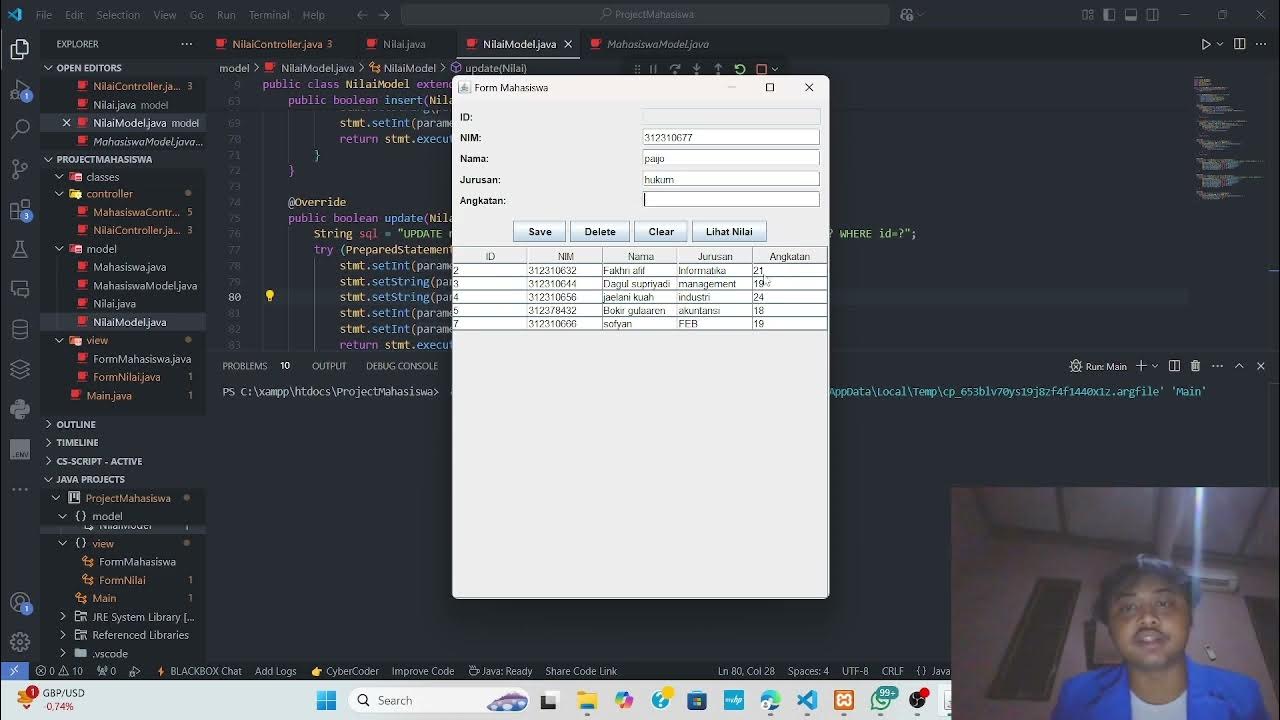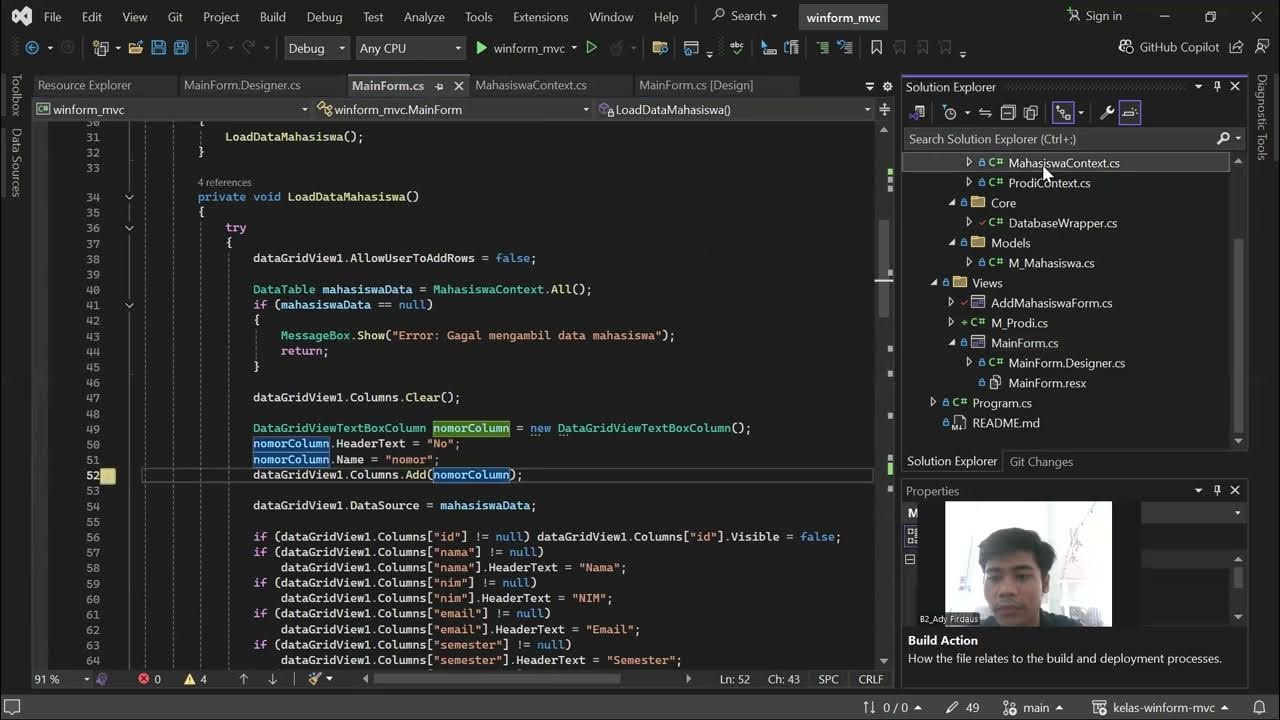Konsep MVC Pada Java || Presentasi & Program
Summary
TLDRThis video provides an in-depth explanation of the Model-View-Controller (MVC) design pattern in Java programming. It introduces the concept of MVC and breaks down its three main components: Model, View, and Controller. The Model represents the data, the View handles the user interface, and the Controller manages interactions between the View and Model. The video also emphasizes the benefits of using MVC for long-term maintainability, using a hospital management system example to demonstrate how MVC allows for easy modifications without affecting the entire program. Overall, it highlights the modularity and scalability MVC brings to software development.
Takeaways
- 😀 MVC (Model-View-Controller) is a design pattern used in object-oriented programming to separate data, user interface, and control logic into distinct components.
- 😀 The Model represents the data structure in an application, typically using Java classes with attributes and getter methods.
- 😀 The View is responsible for the user interface and displays information to the user. It serves as the medium for user interaction.
- 😀 The Controller handles the business logic and connects the Model and View components. It responds to user actions and modifies the Model or View accordingly.
- 😀 Implementing MVC may be challenging at first, but it leads to easier maintenance of the code in the long run, allowing developers to modify one component without affecting the others.
- 😀 An example of MVC's utility is shown with a hospital management system. If the system needs to be adapted from desktop to web, only the View class needs to be changed, not the Model or Controller.
- 😀 The Model in Java typically consists of data classes with properties and methods like getters and setters to access and modify data.
- 😀 The Data Access Object (DAO) handles database interactions, performing CRUD (Create, Read, Update, Delete) operations on the data.
- 😀 The database component contains classes responsible for establishing database connections and providing objects for other classes that need them.
- 😀 The script emphasizes the importance of separating concerns in an application to simplify future modifications and make code more maintainable and scalable.
Q & A
What is the MVC concept in Java programming?
-The Model-View-Controller (MVC) concept is a design pattern used in object-oriented programming. It separates the application into three components: Model (data representation), View (UI), and Controller (manages the flow of data between Model and View).
How does the MVC pattern help in long-term code maintenance?
-The MVC pattern helps in long-term code maintenance by separating concerns into different classes. This allows developers to modify or update one part of the application (e.g., the View) without affecting the other parts (e.g., Model and Controller).
Can you provide an example of how the MVC concept can be applied in a real-world project?
-An example is a hospital management application. If it is built as a desktop application and needs to be converted to a web-based application, only the View (UI) classes need to be changed, while the Model and Controller remain the same.
What is the role of the 'View' in the MVC pattern?
-The View in MVC is responsible for presenting the user interface of the program. It is what the user interacts with and displays the data. The View receives user input and sends related requests to the Controller.
What does the Controller do in the MVC pattern?
-The Controller handles the overall program flow, contains the business logic, and acts as an intermediary between the View and the Model. It processes user requests, updates the Model, and updates the View accordingly.
What is the purpose of the 'Model' in the MVC architecture?
-The Model represents the data structure in the application. It contains the properties and methods necessary to manipulate the data, and it is typically represented by Java classes with getters and setters for data attributes.
What are the key characteristics of the 'Model' in Java?
-In Java, the Model typically consists of classes with attributes (properties) and getter/setter methods. These classes represent the structure of data, and they don’t typically include business logic, focusing solely on data representation.
What is a Data Access Object (DAO) in the MVC pattern?
-The Data Access Object (DAO) is a class in the MVC pattern that performs CRUD (Create, Read, Update, Delete) operations on data stored in a database. It acts as an intermediary between the database and the Model.
What is the function of the 'Database' component in the MVC framework?
-The Database component is responsible for managing the connection between the application and the database. It provides the necessary connections to allow the DAO to interact with the database, ensuring smooth data retrieval and manipulation.
How does the MVC pattern handle user input?
-User input is captured by the View. The View then sends a request to the Controller, which processes the input, performs any necessary business logic, updates the Model, and then updates the View to reflect the changes.
Outlines

This section is available to paid users only. Please upgrade to access this part.
Upgrade NowMindmap

This section is available to paid users only. Please upgrade to access this part.
Upgrade NowKeywords

This section is available to paid users only. Please upgrade to access this part.
Upgrade NowHighlights

This section is available to paid users only. Please upgrade to access this part.
Upgrade NowTranscripts

This section is available to paid users only. Please upgrade to access this part.
Upgrade Now5.0 / 5 (0 votes)





